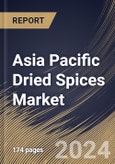The dried spices market stands at the intersection of culinary tradition, agricultural practices, and evolving consumer preferences. As an integral segment of the broader food and beverage industry, dried spices enhance the flavors, aromas, and overall sensory experiences of various dishes worldwide. Adopting dried spices has transcended cultural boundaries, becoming integral to cuisines. The food culture, coupled with increased travel and communication, has facilitated the exchange of culinary practices, leading to a widespread appreciation and utilization of dried spices in kitchens.
Additionally, packaging innovation plays a crucial role in attracting consumers. The market has seen an influx of creatively designed and functional packaging that preserves the freshness of dried spices and enhances shelf appeal. Innovations in packaging materials include using barrier films and laminates that enhance protection against external factors such as moisture, light, and air. These barriers shield the dried spices from environmental elements, ensuring longevity and optimal quality. Convenience is a key consideration for consumers, and packaging innovations address this by incorporating features such as zipper seals and resealable pouches. These additions allow users to easily access the spices while keeping the remaining product securely sealed, preventing moisture and air ingress.
The China market dominated the Asia Pacific Dried Spices Market by Country in 2022, and would continue to be a dominant market till 2030; thereby, achieving a market value of $1509.7 million by 2030. The Japan market is registering a CAGR of 4.1% during (2023 - 2030). Additionally, The India market would experience a CAGR of 5.4% during (2023 - 2030).
A heightened interest in culinary diversity and globalization marks China's evolving food sector. Consumers are more open to exploring international cuisines, creating a demand for a wide variety of dried spices that can be used to replicate authentic flavors. Therefore, the increasing spices production and food sector growth in Asia Pacific will lead to increased demand for dried spices in the region.
Based on Source, the market is segmented into Natural and Organic. Based on Form, the market is segmented into Powder, Whole, and Granules. Based on Application, the market is segmented into Food & Beverage Industry, Foodservice Industry, and Retail. Based on Product Type, the market is segmented into Pepper, Ginger, Cinnamon, Cumin, Turmeric, Cardamom, Cloves, Nutmeg & Mace and Others. Based on countries, the market is segmented into China, Japan, India, South Korea, Singapore, Malaysia, and Rest of Asia Pacific.
List of Key Companies Profiled
- Olam Group Limited
- EVEREST Food Products Pvt. Ltd.,
- Bart Ingredients Company Ltd.
- DS Group
- McCormick & Company, Inc.
- Sauer Brands
- Nestle S.A
- The Spice House
- Frontier Co-op.,
- Firmenich SA
Market Report Segmentation
By Source (Volume, Tonnes, USD Billion, 2019-2030)- Natural
- Organic
- Powder
- Whole
- Granules
- Food & Beverage Industry
- Foodservice Industry
- Retail
- Pepper
- Ginger
- Cinnamon
- Cumin
- Turmeric
- Cardamom
- Cloves
- Nutmeg & Mace
- Others
- China
- Japan
- India
- South Korea
- Singapore
- Malaysia
- Rest of Asia Pacific
Table of Contents
Companies Mentioned
- Olam Group Limited
- EVEREST Food Products Pvt. Ltd.,
- Bart Ingredients Company Ltd.
- DS Group
- McCormick & Company, Inc.
- Sauer Brands
- Nestle S.A
- The Spice House
- Frontier Co-op.,
- Firmenich SA








